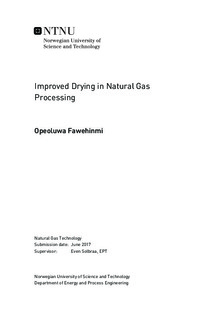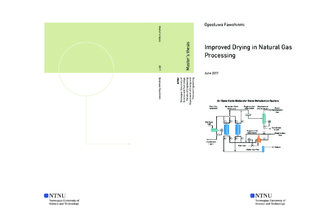| dc.description.abstract | In Natural Gas Processing, dehydration is a very important process especially when the natural gas is being transported over long distances as LNG. There are basically two types of dehydration process, TEG absorption and adsorption by desiccant materials. The adsorption dehydration is the most dominant process in the LNG plant, but prior to this process, TEG absorption is usually done upstream of the LNG plant to make the gas transportable to the LNG plant. After TEG absorption, there is always a small portion of TEG that is carried over by the dried natural gas to downstream processes. This TEG impacts the adsorption process negatively. There are also other factors that affect an adsorption process, these factors range from operating parameters of the adsorption column, the feed gas inlet conditions, and other factors that vary from plant to plant.
A Matlab model has been developed to simulate an adsorption process. The bed saturation and mass transfer has been modelled and simulated. Also, a heat transfer model has been developed to examine the temperature interactions between the gas, adsorbent and column wall. The bed saturation length was found to be dependent on the duration of the adsorption time in an adsorption cycle. The longer the adsorption time, the longer the bed saturation or the equilibrium zone. For an adsorption time of 50 minutes, the equilibrium zone length was 1.2 meters, for 100 minutes, the equilibrium zone length was 1.4 meters and 3.5 meters for 240 minutes. The longer the equilibrium zone, the further down the mass transfer zone is pushed towards the column bottom. The MTZ length has been kept constant in this project work, although in practice the MTZ length increases towards the exit of the column.
The bed loading in an adsorption process is also affected by the feed gas conditions, such as the feed gas temperature and water saturation. From simulations, the feed gas temperature is seen to have inverse effect on the bed loading. The temperature was decreased from base case value of 27 0C to 10 0C and this increased the bed loading from 38.5% weight to 40.0% weight. Conversely, when the temperature was increased from 27 0C to 50 0C, the bed loading reduced to 35.5% weight. The feed gas temperature is usually determined by the upstream process before the adsorption column, usually a scrubber. This scrubber temperature determines how much water is collected in the scrubber.
The bed loading is also seen to be affected by feed gas water saturation from simulations. This has a direct effect on the bad loading. When the water saturation was decreased from 730 ppm (base case) to 200 ppm, the bed loading reduced to 35.0% from 38.5% weight (base case). Similarly, when the water saturation was increased to 930 ppm, the bed loading increased to 39.5% weight. This is simple to understand, as the water saturation determines how much water comes into the column with the gas, and hence how much water is retained in the bed.
The heat transfer model did not show any difference in the temperatures of the gas, adsorbent and column wall throughout the column length. In industry and normal practice, there is a slight temperature difference between the gas, adsorbent and wall towards the bottom or exit of the column. In this project work, this difference was not noticed, rather the gas, adsorbent and wall temperature all remained 27 0C throughout the column. This could be due to several reasons, but the most likely reason here is that the Matlab model could have been faulty and there was no time to figure out where this fault was. | |

